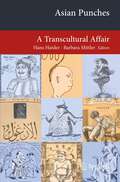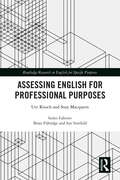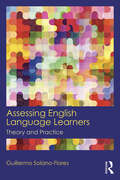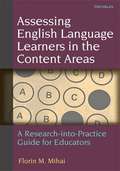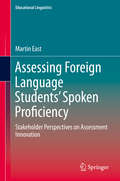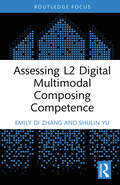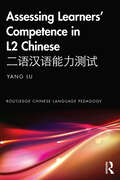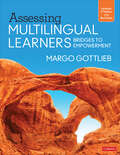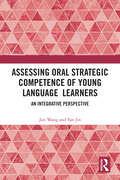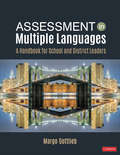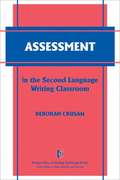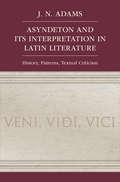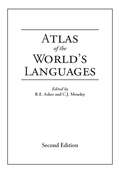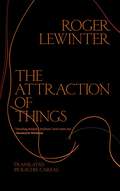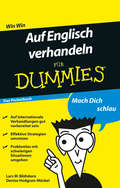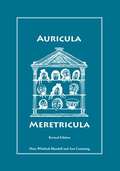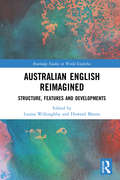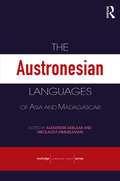- Table View
- List View
Asian Punches: A Transcultural Affair (Transcultural Research – Heidelberg Studies on Asia and Europe in a Global Context)
by Barbara Mittler Hans HarderThis book deals with Punches and Punch-like magazines in 19th and 20th century Asia, covering an area from Egypt and the Ottoman Empire in the West via British India up to China and Japan in the East. It traces an alternative and largely unacknowledged side of the history of this popular British periodical, and simultaneously casts a wide-reaching comparative glance on the genesis of satirical journalism in various Asian countries. Demonstrating the spread of both textual and visual satire, it is an apt demonstration of the transcultural trajectory of a format intimately linked to media-bound public spheres evolving in the period concerned.
Aspirations and Challenges for Undocumented Student Success: Critical Readings and Testimonios
by Enrique G. Murillo Sharon Velarde PierceAspirations and Challenges for Undocumented Student Success offers a comprehensive review of rigorous, innovative, and critical scholarship profiling the scope and terrain on undocumented student success. Compiling the most significant work in the field in terms of its contributions to research and professional practice, the volume opens with an exploration the aspirations of undocumented students and the fight for equity, followed by an examination of the impact and influence of parents and families on educational outcomes. Finally, it concludes with testimonios reflecting on the educational experiences of undocumented students in America. Each section presents readings in chronological order, demonstrating the progression around undocumented student success in the field over the past 20+ years, in respect to the intentionality about integrating undocumented student success throughout equity initiatives, breaking down institutional silos, fostering welcoming campus environments, and advocating for solutions that allow undocumented students to achieve economic mobility in both policy and practice. This text is a must-have resource for graduate students and researchers in Educational Leadership and Policy, Multicultural Education, and Teacher Education. It will also be important reading for educational leaders, teachers, counselors, administrators, and organizations that share a common interest in and commitment to the educational issues that impact undocumented students and their families.
Assessing English for Professional Purposes (Routledge Research in English for Specific Purposes)
by Ute Knoch Susy MacqueenAssessing English for Professional Purposes provides a state-of-the-art account of the various kinds of language assessments used to determine people’s abilities to function linguistically in the workplace. At a time when professional expertise is increasingly mobile and diverse, with highly trained professionals migrating across national boundaries to apply their skills in English-speaking settings, this book offers a renewed agenda for inquiry into language assessments for professional purposes (LAPP). Many of these experts work in high-risk environments where communication breakdowns can have serious consequences. This risk has been identified by governments and professional bodies, who implement language tests for gate-keeping purposes. Through a sociological lens of risk and responsibility, this book: provides a detailed overview of both foundational and recent literature in the field; offers conceptual tools for specific purpose assessment, including a socially oriented theory of construct; develops theory and practice in key areas, such as needs analysis, test development, validation and policy; significantly broadens the scope of the assessment of English for professional purposes to include a range of assessment practices for both professionals and laypeople in professional settings. Assessing English for Professional Purposes is key reading for researchers, graduate students and practitioners working in the area of English for Specific Purposes assessment.
Assessing English Language Learners: Theory and Practice
by Guillermo Solano FloresAssessing English Language Learners explains and illustrates the main ideas underlying assessment as an activity intimately linked to instruction and the basic principles for developing, using, selecting, and adapting assessment instruments and strategies to assess content knowledge in English language learners (ELLs). Sensitive to the professional development needs of both in-service and pre-service mainstream teachers with ELLs in their classrooms and those receiving formal training to teach culturally and linguistically diverse students, the text is designed to engage readers in viewing assessment as a critical part of teaching appreciating that assessments provide teachers with valuable information about their students’ learning and thinking becoming aware of the relationship among language, culture, and testing understanding the reasoning that guides test construction recognizing the limitations of testing practices being confident that assessment is an activity classroom teachers (not only accountability specialists) can perform Highlighting alternative, multidisciplinary approaches that address linguistic and cultural diversity in testing, this text, enhanced by multiple field-tested exercises and examples of different forms of assessment, is ideal for any course covering the theory and practice of ELL assessment.
Assessing English Language Learners In The Content Areas: A Research-into-practice Guide For Educators
by Florin MihaiAssessing English Language Learners in the Content Areas: A Research-into-Practice Guide for Educators seeks to provide guidance to classroom teachers, staff developers, and test-item designers who want to improve ELL assessment outcomes, particularly in the areas of math, science and social studies. The first two chapters of the book establish the background for the discussion of content-area assessment for ELLs, examining several important characteristics of this rapidly growing student population (as well as critical legislation affecting ELLs) and providing a description of various forms of assessment, including how ELL assessment is different from the assessment of English-proficient students Important assessment principles that educators should use in their evaluation of tests or other forms of measurement are provided. Other chapters review ELL test accommodations nationwide (because, surprisingly, most teachers do not know what they can and cannot allow) and the research on the effectiveness of these types of accommodations. The book analyzes the characteristics of alternative assessment; it discusses three popular alternative assessment instruments (performance assessment, curriculum-based measurement, and portfolios) and makes recommendations as to how to increase the validity, reliability, and practicality of alternative assessments. The book proposes fundamental assessment practices to help content area teachers in their evaluation of their ELL progress.
Assessing Foreign Language Students' Spoken Proficiency: Stakeholder Perspectives on Assessment Innovation (Educational Linguistics #26)
by Martin EastThis book presents an indepth study of assessment innovation and its impact on teaching and learning. The context is New Zealand, and the focus is additional languages other than English and the recent introduction of a radical new assessment of students' spoken proficiency, called interact. The book crosses the traditional theoretical and methodological boundaries associated with language testing research, which focuses on assessment performance, and presents an alternative approach where stakeholders become the centre of interest. It advances our understanding of how assessment innovation impacts on two key groups - teachers and students in schools - based on data collected from a substantial twoyear research project. It presents an account of these stakeholders' perceptions of the validity and usefulness of the new assessment in comparison with the more traditional test that it has replaced. Assessing Foreign Language Students' Spoken Proficiency makes an outstanding and original contribution to the field of second and foreign language teaching, providing a theory and research-based account of the development of a learner-centred approach to oral proficiency assessment. It is an important resource for teachers and teacher educators as well as assessment and curriculum specialists worldwide. It deserves to be widely read.
Assessing L2 Digital Multimodal Composing Competence (Routledge Focus on Applied Linguistics)
by Emily Di Zhang Shulin YuThis book focuses on assessing L2 student digital multimodal composing (DMC) competence. It explores key themes, including the conceptualization of L2 student DMC competence, and the development, validation, and utilization of L2 student DMC competence in the tertiary context.Through a thorough review of the DMC literature, the book furnishes readers with a theoretical framework to comprehensively grasp the underlying constructs of L2 student DMC competence. It also provides a delineation of the process of scale development, i.e., defining constructs, constructing items, and analyzing items, scale validation, i.e., the structural, external, and consequential construct validity of the scale, and scale utilization in students’ DMC self- and peer-assessment practices.This practical guidance equips educators and practitioners with the necessary tools and strategies to effectively assess and enhance L2 students’ DMC competence. Scholars and professionals in the fields of L2 writing, language assessment, digital literacy, and technology-enhanced language learning will gain valuable insights from the content.
Assessing Language and Literacy with Bilingual Students: Practices to Support English Learners
by Lori Helman Anne C. Ittner Kristen L. McMasterFrom expert authors, this book guides educators to conduct assessments that inform daily instruction and identify the assets that emergent bilinguals bring to the classroom. Effective practices are reviewed for screening, assessment, and progress monitoring in the areas of oral language, beginning reading skills, vocabulary and comprehension in the content areas, and writing. The book also addresses how to establish schoolwide systems of support that incorporate family and community engagement. Packed with practical ideas and vignettes, the book focuses on grades K–6, but also will be useful to middle and high school teachers. Appendices include reproducible forms that can be downloaded and printed in a convenient 8 1/2" x 11" size.
Assessing Learners’ Competence in L2 Chinese 二语汉语能力测试 (Routledge Chinese Language Pedagogy)
by Yang LuAssessing Learners’ Competence in L2 Chinese is the first book intended to answer the question on whether existing standardised and classroom-based assessments can reflect learners’ competence in L2 Chinese. The Chinese language has enjoyed increasing global popularity amongst second/foreign language learners and has become one of the major modern languages for school and university curricula. However, to many teachers and researchers, it has been difficult to answer with confidence whether the existing standardised and classroom tests can reflect learners’ competence in L2 Chinese. This book defines and redefines the constructs for assessing L2 Chinese competence that have been overlooked or misplaced because of the unique features of the Chinese language. The book provides theoretical backgrounds and practical methodologies for assessing competence in L2 Chinese trainees and experienced teachers of Chinese as a second language. It will provide invaluable guidelines and ready-made workshop materials for postgraduate teacher training programmes. Researchers and academics will find innovative frameworks on the subject for further studies and debates.
Assessing Multilingual Learners: Bridges to Empowerment
by Margo GottliebEmpowering multilingual learners, families, and teachers With its emphasis on relationship building as the backdrop for linguistically and culturally sustainable assessment, the bestselling second edition of Assessing Multilingual Learners significantly impacted the field of language education. Applying the groundbreaking assessment "as," "for," and "of" learning model to new contexts, this updated third edition offers educators welcoming and encouraging ways to support multilingual learners to succeed in school and beyond. Through eight thoroughly revised chapters, Dr. Margo Gottlieb ties assessment to teaching and learning to foster agency and empowerment for multilingual learners, families, and teachers. This book envisions assessment as a process integral to and embedded in curriculum and instruction through: Assets-based language Student-centered activities Classroom assessment tools Portraits of practice illustrating authentic assessment practices References and resources for stimulating discussion Deep questioning for thinking through processes, dilemmas, or challenges Assessing Multilingual Learners explores the realities and possibilities of classroom assessment as a road to inspire multilingual learners, their families, and teachers to reach great heights.
Assessing Multilingual Learners: Bridges to Empowerment
by Margo GottliebEmpowering multilingual learners, families, and teachers With its emphasis on relationship building as the backdrop for linguistically and culturally sustainable assessment, the bestselling second edition of Assessing Multilingual Learners significantly impacted the field of language education. Applying the groundbreaking assessment "as," "for," and "of" learning model to new contexts, this updated third edition offers educators welcoming and encouraging ways to support multilingual learners to succeed in school and beyond. Through eight thoroughly revised chapters, Dr. Margo Gottlieb ties assessment to teaching and learning to foster agency and empowerment for multilingual learners, families, and teachers. This book envisions assessment as a process integral to and embedded in curriculum and instruction through: Assets-based language Student-centered activities Classroom assessment tools Portraits of practice illustrating authentic assessment practices References and resources for stimulating discussion Deep questioning for thinking through processes, dilemmas, or challenges Assessing Multilingual Learners explores the realities and possibilities of classroom assessment as a road to inspire multilingual learners, their families, and teachers to reach great heights.
Assessing Oral Strategic Competence of Young Language Learners: An Integrative Perspective
by Jun Wang Yan JinThis book presents an empirical study that develops and validates a learning-oriented self-assessment instrument for assessing the strategic competence (SC) of young language learners in oral communication, specifically within the context of early English education in China.The instrument’s development followed a multi-phased research design, encompassing three interconnected stages: conceptualisation, operationalisation and validation. Each phase employed distinct methods, data collection techniques and analyses tailored to specific research objectives. By adopting an integrative approach, this book clarifies the crucial yet elusive concept of SC. It not only contributes to the field of language assessment but also underscores the importance of explicit SC instruction in language education for young learners.Focusing on real-world classroom scenarios and offering practical solutions for integrating SC instruction into current teaching paradigms, this book will appeal to educators, researchers and policymakers interested in language testing and assessment, foreign language education and applied linguistics.
Assessment in Multiple Languages: A Handbook for School and District Leaders
by Margo GottliebAssessing the full capabilities of your multilingual learners Assessment as, for, and of learning complement effective curricular and instructional practices, however, the complexities of assessment for multilingual students are too-often overlooked and misunderstood. What if multilingual learners, teachers, and educational leaders all had opportunities to plan for and use assessment data in multiple languages? Imagine the linguistic, academic, and cultural reservoirs we could tap to highlight what our multilingual learners know and can do. Assessment in Multiple Languages: A Handbook for School and District Leaders shows how superintendents, principals, directors, coaches, and other educational leaders can more accurately portray the academic, language, and social-emotional development of multilingual students. As a companion to Classroom Assessment in Multiple Languages, this book illustrates how the assessment cycle unfolds at school and district levels. Together the two books provide comprehensive guidance for enacting linguistically and culturally sustainable assessment in multiple languages in K-12 settings. Grounded in leading-edge research, with an emphasis on instilling equity and social justice in assessment practices, this book: justifies the legitimacy of assessment in multiple languages showcases examples from federal to classroom levels provides practical guidance and tools for schoolwide and district level assessment applies to any and all programs with multilingual learners whether in dual-language immersion, bilingual, or monolingual settings. Written by leading multilingual education and assessment authority Margo Gottlieb, this guide will help educational leaders highlight the true capabilities of multilingual learners.
Assessment in Multiple Languages: A Handbook for School and District Leaders
by Margo GottliebAssessing the full capabilities of your multilingual learners Assessment as, for, and of learning complement effective curricular and instructional practices, however, the complexities of assessment for multilingual students are too-often overlooked and misunderstood. What if multilingual learners, teachers, and educational leaders all had opportunities to plan for and use assessment data in multiple languages? Imagine the linguistic, academic, and cultural reservoirs we could tap to highlight what our multilingual learners know and can do. Assessment in Multiple Languages: A Handbook for School and District Leaders shows how superintendents, principals, directors, coaches, and other educational leaders can more accurately portray the academic, language, and social-emotional development of multilingual students. As a companion to Classroom Assessment in Multiple Languages, this book illustrates how the assessment cycle unfolds at school and district levels. Together the two books provide comprehensive guidance for enacting linguistically and culturally sustainable assessment in multiple languages in K-12 settings. Grounded in leading-edge research, with an emphasis on instilling equity and social justice in assessment practices, this book: justifies the legitimacy of assessment in multiple languages showcases examples from federal to classroom levels provides practical guidance and tools for schoolwide and district level assessment applies to any and all programs with multilingual learners whether in dual-language immersion, bilingual, or monolingual settings. Written by leading multilingual education and assessment authority Margo Gottlieb, this guide will help educational leaders highlight the true capabilities of multilingual learners.
Assessment in the Second Language Writing Classroom
by Deborah CrusanAssessment in the Second Language Writing Classroom is a teacher and prospective teacher-friendly book, uncomplicated by the language of statistics. The book is for those who teach and assess second language writing in several different contexts: the IEP, the developmental writing classroom, and the sheltered composition classroom. In addition, teachers who experience a mixed population or teach cross-cultural composition will find the book a valuable resource. Other books have thoroughly covered the theoretical aspects of writing assessment, but none have focused as heavily as this book does on pragmatic classroom aspects of writing assessment. Further, no book to date has included an in-depth examination of the machine scoring of writing and its effects on second language writers. Crusan not only makes a compelling case for becoming knowledgeable about L2 writing assessment but offers the means to do so. Her highly accessible, thought-provoking presentation of the conceptual and practical dimensions of writing assessment, both for the classroom and on a larger scale, promises to engage readers who have previously found the technical detail of other works on assessment off-putting, as well as those who have had no previous exposure to the study of assessment at all.
Asyndeton and its Interpretation in Latin Literature: History, Patterns, Textual Criticism
by J. N. AdamsAsyndetic coordination (omission of coordinators such as 'but', 'or', 'and') is ancient in Indo-European languages. Most commentaries on Greek and Latin texts index 'asyndeton', but wide-ranging treatments of asyndeton across a variety of literary and non-literary genres are largely lacking, and comments are often impressionistic. This book provides the most comprehensive account of asyndeton in Latin ever attempted, and it also contains material from Greek and Umbrian. It analyses asyndeta in diverse genres from early Latin to the early Empire, including prayers and laws, and aims to identify types, determinants, generic variations and chronological changes. Since coordinators are easily left out or added by scribes, criteria are discussed that might be used by editors in deciding between asyndeton and coordination. External influences on Latin, such as Greek and Italic, are also considered. The book will be essential for all scholars of Latin language and literature as well as historical linguistics.
Atlas of the World's Languages: Context And Process (Memory Of Peoples Ser.)
by R. E. Asher and Christopher MoseleyBefore the first appearance of the Atlas of the World's Languages in 1993, all the world's languages had never been accurately and completely mapped. The Atlas depicts the location of every known living language, including languages on the point of extinction. This fully revised edition of the Atlas offers: up-to-date research, some from fieldwork in early 2006 a general linguistic history of each section an overview of the genetic relations of the languages in each section statistical and sociolinguistic information a large number of new or completely updated maps further reading and a bibliography for each section a cross-referenced language index of over 6,000 languages. Presenting contributions from international scholars, covering over 6,000 languages and containing over 150 full-colour maps, the Atlas of the World's Languages is the definitive reference resource for every linguistic and reference library.
Attitudes to English Study among Japanese, Chinese and Korean Women: Motivations, Expectations and Identity (Routledge Research in Language Education)
by Yoko KobayashiThis edited book comprises chapters integrated around a central theme on college-educated Japanese, Korean, and Chinese women’s orientation to English study. The collection is composed of two parts: (1) East Asian women’s motivation to study in the West and (2) East Asian women’s dream to use English as a career. The first part discusses their international migration as facilitated by factors characteristic of East Asian nations (e.g. middle-class women’s access to advanced education and yet unequal access to professional career) and other factors inherent in each nation (e.g. different social evaluations of women equipped with competitive overseas degrees and English proficiency). The second part sheds light on the dreams and realities of East Asian female adults who, having been avid English learners, aim for "dream jobs" (e.g. interpreters) or have few other career choices but to be re-trained as English specialists or even as Japanese language teachers working abroad. This collection is suitable for any scholar interested in the lives and voices of young educated women who strive to empower themselves with language skills in the seemingly promising neoliberal world that is, however, riddled with ideological contradictions.
The Attraction of Things
by Roger Lewinter Rachel CareauStunning fragments that offer an epiphany of grace and beauty The Attraction of Things concerns the entirety of beauty and the possibility of grace, relayed via obsessions with rare early gramophone records, the theater, translation, dying parents: all these elements are relayed in a dizzying strange traffic of cultural artifacts, friendships, losses, discoveries, and love. Roger Lewinter believes that in the realm of art, "the distinction between life and death loses its relevance, the one taking place in the other." Whereas Story of Love in Solitude is a group of small stories, The Attraction of Things is a continuous narrative (more or less) of a man seeking (or stumbling upon) enlightenment. "The Attraction of Things," states Lewinter, "is the story of a being who lets himself go toward what attracts him, toward what he attracts--beings, works, things--and who, through successive encounters, finds the way out of the labyrinth, to the heart, where the bolt of illumination strikes. This is the story of a letting go toward the illumination."
Auf Englisch verhandeln fur Dummies Das Pocketbuch (Für Dummies)
by Dr. Lars M. Blöhdorn Denise Hodgson-MöckelNicht jeder, der souverän und erfolreich eine Verhandlung führen kann, fühlt sich auch im Umgang mit englischsprachigen Verhandlungspartnern sicher. Lars M. Blöhdorn und Denise Hodgson-Möckel geben Ihnen die wichtigsten Vokabeln und Redewendungen für Verhandlungen auf Englisch an die Hand. Die Autoren verraten Ihnen auch, wie sie so manche Klippe bei schwierigen Verhandlungen umschiffen können. So können Sie gelassen und gut vorbereitet Ihrer nächsten Verhandlung auf Englisch entgegensehen.
Auricula Meretricula
by Ann Cumming Ruby Blondell Mary Whitlock BlundellAuricula Meretricula is a unique play for students in their first semester of Latin. Each scene uses new forms and vocabulary, thus reinforcing the students’ grasp of grammar by placing it in a living context. At the same time, it provides an enticing introduction to Roman comedy and elegy. <p><p>First published in 1981, Auricula Meretricula was greeted with enthusiasm by students and teachers, and is currently used in many classics departments in the US and elsewhere. This substantially revised edition includes new scenes and characters while reducing the overall quantity of unfamiliar vocabulary.
Australian English Reimagined: Structure, Features and Developments (Routledge Studies in World Englishes)
by Howard Manns Louisa WilloughbyAustralian English is perhaps best known for its colourful slang, but the variety is much richer than slang alone. This collection provides a detailed account of Australian English by bringing together leading scholars of this English variety. These scholars provide a comprehensive overview of Australian English’s distinctive features and outline cutting-edge research into the variation and change of English in Australia. Organised thematically, this volume explores the ways in which Australian English differs from other varieties of English, as well as examining regional, social and stylistic variation within the variety. The volume first explores particular structural features where Australian English differentiates itself from other English varieties. There are chapters on phonetics and phonology, socio-phonetics, lexicon and discourse-pragmatics as these elements are core to understanding any variety of English, especially within the World Englishes paradigm. It then considers what are arguably the most salient aspects of variation within Australian English and finally focuses on historical, attitudinal and planning aspects of Australian English. This volume provides a thorough account of Australian English and its users as complex, diverse and worthy of study. Perhaps more importantly, this volume’s scholars provide a reimagining of Australian English and the paradigm through which future scholars may proceed.
Australian Sign Language (Auslan)
by Trevor Johnston Adam SchembriThis is first comprehensive introduction to the linguistics of Auslan, the sign language of Australia. Assuming no prior background in language study, it explores each key aspect of the structure of Auslan, providing an accessible overview of its grammar (how sentences are structured), phonology (the building blocks of signs), morphology (the structure of signs), lexicon (vocabulary), semantics (how meaning is created), and discourse (how Auslan is used in context). The authors also discuss a range of myths and misunderstandings about sign languages, provide an insight into the history and development of Auslan, and show how Auslan is related to other sign languages, such as those used in Britain, the USA and New Zealand. Complete with clear illustrations of the signs in use and useful further reading lists, this is an ideal resource for anyone interested in Auslan, as well as those seeking a clear, general introduction to sign language linguistics.
The Austronesian Languages of Asia and Madagascar (Routledge Language Family Ser. #Vol. 7)
by Alexander Adelaar Nikolaus P. HimmelmannSome 800 Austronesian languages are spoken in the area extending from Madagascar to eastern Indonesia and to the north to Taiwan and the Philippines. They vary greatly in almost every possible respect, including the size and social make-up of the speech communities and their typological profiles. This book is designed to serve as a reference work a
Autentico 2018: Leveled Vocabulary and Grammar Workbook Level 2
by Prentice-Hall StaffAutentico 2018 Leveled Vocabulary and Grammar Workbook Level 2
